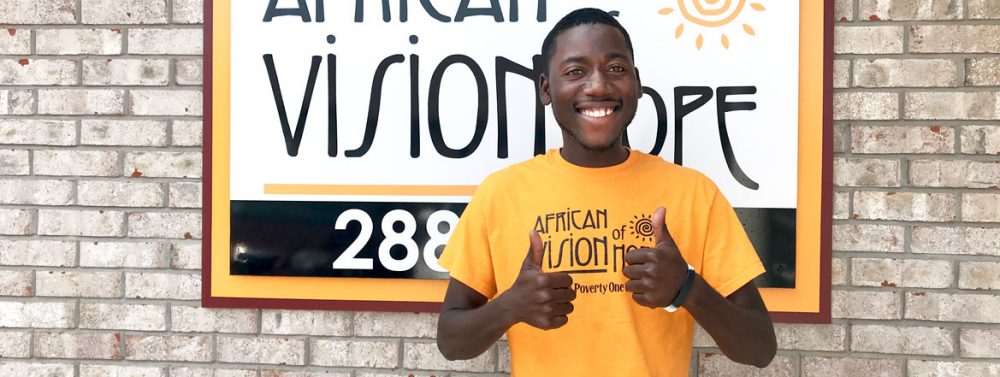When Misheck first stepped foot off of an airplane onto US soil, the contrast between this world and the one he left was drastic. He left a place where most homes are made of mud bricks and tin roofs and arrived in a country where cars can park themselves. Misheck is an African Vision of Hope employee working across the globe in Zambia. Before he became a member of the team, he was a student at our school in Kabulonga, Zambia. Misheck is here in the USA for one month speaking and sharing the stories of lives changed by incredible African Vision of Hope donors. This is his 3rd trip to America, and often Misheck gets asked the question “What are the differences between the United States and Zambia? What shocked you when you first came here?” Misheck has first-hand perspective on the subject of the differences between a first and a third-world country. So, we asked him, “What shocked you the most when you stepped off the plane into the USA?”
The Roads
“First, it was the roads. Everywhere I have gone here in America the roads are well-paved. I remember telling my friends when I went back to Zambia that, the whole time I was here, I never cleaned my shoes. In Zambia, even after walking 3 minutes, you have to clean your shoes because of the dust and dirt. No roads or sidewalks are paved. Here, you have street lights everywhere. Also, you have no street vendors. In Zambia you cannot walk or drive anywhere without seeing many street vendors. That is mostly the only employment most people can find.”

The Food
“Eating here is very different. You have so many restaurants and many food options. Also, when you walk into an American house, you see the refrigerator. The refrigerator is filled with food, but yet you go out and eat at a restaurant. Back home, if you had a fridge like that with a lot of food, you would never want to leave the house. You do not see that kind of abundance in Zambia. In America, you do not have a staple food that you eat with every meal. In Zambia, we eat nshima (a cornmeal paste that looks like mashed potatoes) with every meal. For families that cannot afford three meals a day, they eat nshima, nshima, and nshima. When it comes to meal time, here in the USA families eat at the same table together. They talk about their day and get to know each other. Parents ask their children how they are doing. Back home, we don’t do that. We don’t eat together. The father eats alone and the mother and children eat separately.
The Culture
“In Zambia, we have a lot of culture and traditions that we celebrate. We have 72 local languages. Here, you speak one main language. The relationship between in-laws is extremely different. Here, mother-in-laws and daughter-in-laws interact and are open with one another. In Zambia, they greet each other at a distance. Daughter-in-laws have to kneel to their mother-in-laws. Your greetings also surprised me. Here, if you see a peer who is older than you, you address them by name. Back home, you must say “sir” or “mister” or something that shows them respect. There is not much interaction between elders and youth. Here, things get done fast. You are a more developed nation. At home, things are slow. Even to deposit money into the bank is slow. Once, I went with dad (Bob Bertels) to deposit money and he put the check in a can. A machine sucked up the can, and the money disappeared! That was something new to me. That is something you would never see in Zambia. Everything here is fast-fast-fast. Also, back home, people do not save their money. Here, a 16 year-old child will have a car and their family will be saving for their college. Back home, it is hand to mouth. They use what they make to survive day by day. “
The Education
“I have learned that, here in America, every child goes to school. School buses come by to pick them up. In Zambia, it is very different. School is not free, so many children cannot go. Plus, many have to walk great distances to reach their classes. People are very creative in the USA. It is impressive. They have the education and the tools they need to create buildings and monuments and works of art. Going up into the St. Louis Arch was awesome. I doubt if anyone in my country could construct a monument like that. It takes a lot of money and calculations. Technology is abundant here.”
The Homes
“People here have space. Back home, you will find 4 or 5 guys living in a 1 room house. Here, everyone has their own room and their own bed. Also, our homes are made of concrete blocks, not wood like here in America. Before coming here, I thought things were cheap in the USA. I have now come to understand how valuable a dollar is. Things here are expensive. Life is expensive. In Zambia, rent for a two bedroom home in the capital city is $100 American dollars per month.”
“The first look I got of the USA was the airport, and compared to the airport in Zambia, I knew America was going to be very different from home.”
African Vision of Hope will continue to educate Zambia’s children and youth until every single orphan or vulnerable child is able to have an education. When children are educated, a whole world of possibilities opens up for them. They are able to change their country and close the gap between our 2 vastly different worlds. Misheck always brings a fresh perspective with him everywhere he goes. Watch the video below to follow Misheck as he walks us through the differences in our worlds himself.


